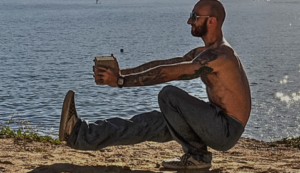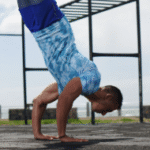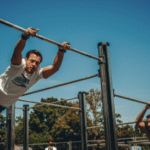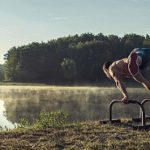Pistol Squats: Master the One-Legged Wonder
The pistol squat, a true testament to lower body strength, balance, and mobility, is often called the “king of bodyweight leg exercises.” This advanced movement requires you to squat down on one leg while extending the other leg forward, resembling the shape of a pistol. While challenging, mastering the pistol squat unlocks incredible strength, athleticism, and a sense of accomplishment. This guide will delve into the benefits, proper form, progressions, and training tips to help you conquer this one-legged wonder.
Why Pistol Squats are a Leg Day Game-Changer:
Unilateral Strength and Muscle Growth: Pistol squats build exceptional strength and muscle mass in your quads, glutes, hamstrings, and calves. Working one leg at a time reveals and addresses any strength imbalances, leading to more balanced lower body development.
Enhanced Balance and Coordination: Balancing on one leg throughout the entire movement requires exceptional balance, coordination, and proprioception (body awareness).
Improved Mobility and Flexibility: Pistol squats demand a good range of motion in your ankles, knees, and hips, promoting flexibility and mobility in these joints.
Functional Strength: They mimic single-leg movements used in everyday activities and sports, making you stronger and more agile in real-life scenarios.
Increased Joint Stability: Pistol squats strengthen the muscles surrounding your knees and ankles, improving joint stability and reducing the risk of injuries.
Mental Fortitude: Mastering pistol squats requires dedication, discipline, and mental focus, building mental resilience alongside physical strength.
Impressive Skill: Performing a pistol squat is a visually impressive feat of strength and control, demonstrating mastery over your body.
Mastering the Pistol Squat:
Prerequisites: Before attempting pistol squats, you should have a solid foundation in basic squats and be able to perform variations like deep squats and Bulgarian split squats with good form.
Starting Position:
Single-Leg Stance: Stand tall on one leg, with your core engaged and your other leg extended forward, parallel to the ground.
Arms Forward: Extend your arms forward for balance.
Foot Placement: Keep your weight balanced on the heel and midfoot of your supporting leg.
Lowering Phase:
Controlled Descent: Slowly lower your body towards the ground by bending your supporting knee and sitting back as if into a chair.
Extended Leg: Keep your extended leg parallel to the ground throughout the movement.
Depth: Aim to lower your hips until your hamstring touches your calf.
Pushing Phase:
Drive Up: Push through your heel to return to the starting position, extending your hip and knee.
Full Extension: Stand tall at the top of the movement.
Common Mistakes to Avoid:
Heel Lifting: Keep your heel flat on the ground throughout the movement. If your heel lifts, it indicates tightness in your ankle or calf muscles.
Knee Cave-In: Push your knee outward to prevent it from collapsing inward.
Leaning Forward: Keep your torso upright and avoid excessive forward lean.
Losing Balance: Engage your core and maintain a controlled descent to avoid losing balance.
Pistol Squat Progressions:
Assisted Pistol Squats: Use a TRX, counterbalance, or a sturdy object to assist with the movement as you build strength.
Box Pistol Squats: Perform pistol squats to a box or bench to reduce the range of motion.
Negative Pistol Squats: Focus on the lowering phase of the pistol squat, slowly lowering yourself down with control.
Shrimp Squats: Perform a similar movement with your back leg bent and your foot held behind you.
Tips for Success:
Gradual Progression: Start with easier progressions and gradually work your way up to full pistol squats as your strength and mobility improve.
Focus on Form: Prioritize proper form over the number of repetitions.
Listen to Your Body: Rest when needed and avoid pushing yourself too hard, especially when starting.
Warm-Up: Prepare your legs, ankles, and hips with dynamic stretches and light exercises before doing pistol squats.
Consistency is Key: Incorporate pistol squat progressions into your workout routine regularly to see consistent progress.
Bonus Resources:
YouTube Tutorials: Search for “pistol squat progressions” or “how to do pistol squats correctly” on YouTube.
Calisthenics Communities: Join online forums or groups dedicated to calisthenics for support, motivation, and advice.
Certified Trainers: Consider working with a certified calisthenics trainer for personalized guidance and feedback.
By mastering pistol squats and incorporating them into your training, you’ll unlock a new level of lower body strength, balance, and mobility. So, embrace the challenge, refine your technique, and conquer this one-legged wonder!

Pistol Squats: Master the One-Legged Wonder
Route
Calisthenics Gym Houston Functional Bodyweight Training
Secondary phone: (346) 483-3195
Email: info@calisthenicsclubhouston.com
URL: https://calisthenicsclubhouston.com/
Monday 6:00 AM - 7:00 PM Tuesday 6:00 AM - 7:00 PM Wednesday 6:00 AM - 7:00 PM Thursday 6:00 AM - 7:00 PM Friday 12:00 PM - 6:30 PM Saturday 9:45 AM - 12:00 PM Sunday 3:00 PM - 5:00 PM





